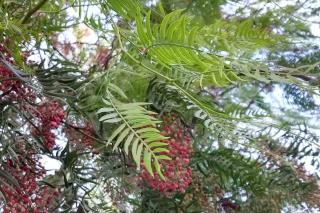

Shinus molle, or pink peppercorn, is an elegant tree native to South America.
Pink Peppercorn facts, a short list
Name: Schinus molle
Common: false pepper, peruvian peppertree
Family: Anacardiaceae
Type: tree
Height: 50 to 65 feet (15 to 20 meters)
Exposure: full sun
Soil: ordinary
Foliage: evergreen – Blooming: spring → fall – Fruit set: summer → fall
It is recommended to plant pink peppercorn in spring, for it to avoid starting off by having to face winter.
Watering is recommended at the beginning, without overdoing it, and it must later be restricted.
Shinus molle doesn’t need any pruning. Let it grow and it’ll be even more appealing. The long, weeping fronds look quite like those of the weeping willow tree.
It will only rarely fall sick.
A common pest you’ll find is black aphid, for which it’s a favorite host plant. Since it attracts these aphids, try not to plant this tree near your citrus (black aphids propagate citrus foot rot among other diseases).

The pink or red berries it produces release a very fragrant scent, close to that of pepper, but aren’t directly edible. After drying them, you can still add a few to recipes, but beware of allergies (same family as the cashew nut).
The blooming is a creamy white or yellow color, grouped in bunches that appear during the month of May.
Pink Peppercorn is an excellent shade tree that resists cold temperatures down to 23°F (-5°C).